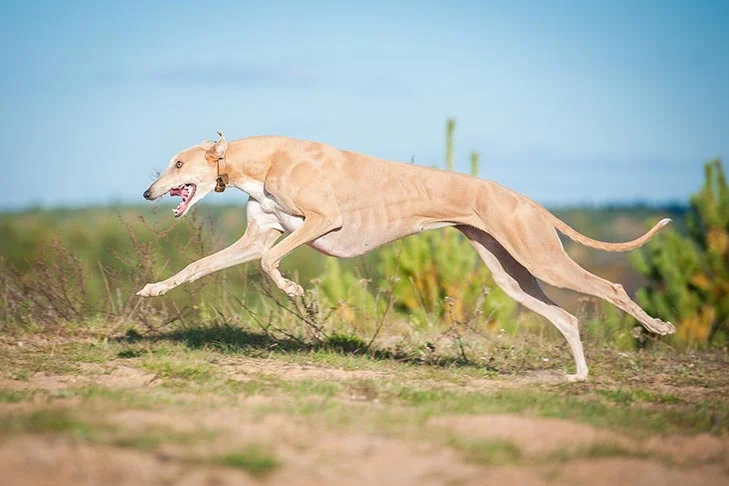The Greyhound, the world’s best sprinting dog, is a kind, honorable, and patient friend with a strong sense of independence. These elegant canines have captured the attention of poets, rulers, and artists for thousands of years. From the tiny, aerodynamic cranium to the shock-absorbing pads on the feet, greyhounds are precisely designed for the fast chase. They are the epitome of the dog breeder’s motto, “Form follows function.” Since the beginning of time, when people first began to refer to themselves as civilized, painters, poets, and monarchs have been captivated by the slender elegance of the Greyhound’s “inverted S” shape, which is produced by the deep chest gently curving into a neatly tucked waist. The greyhound serves as the model for all other coursing hounds.
Greyhound
Average sizes and life
expectancy of the breed.
Height
28-30 inches (male)
27-28 inches (female)
Weight
65-70 pounds (male)
60-65 pounds (female)
Life Expectancy
10-13 years
Breed Traits & Characteristics
About the Breed

Owning a dog is not just a privilege; it’s a responsibility. They depend on us for, at minimum, food and shelter, and deserve much more. When you take a dog into your life, you need to understand the commitment that dog ownership entails.
 Health
Health
Greyhounds are overall very healthy dogs, although there are a few conditions the breed can be prone to. As are most deep-chested breeds, the Greyhound is susceptible to bloat and gastric torsion, a sudden and life-threatening enlargement of the stomach that is sometimes accompanied by twisting. Owners should be aware of the symptoms of bloat and seek medical attention immediately if they occur. A condition called Greyhound neuropathy seems to be isolated in the breed. Other disorders that can occur include cardiac and eye conditions. Responsible breeders screen their stock for conditions that can affect the breed.
 Grooming
Grooming
The Greyhound's short, smooth coat requires little grooming beyond regular baths and weekly rubdowns with a damp cloth or hound glove. His strong, fast-growing nails should be trimmed regularly if not worn down naturally, as overly long nails can cause the dog discomfort. The ears should be checked at least weekly for any buildup of wax or debris that could result in an infection, and cleaned if needed. The teeth should be brushed regularly'¿daily if possible'¿with a toothpaste formulated for dogs.
 Exercise
Exercise
 Training
Training
Training a Greyhound can be frustrating for anyone who does not understand the genetic origins of the Greyhound temperament. As a sighthound, or coursing breed, the Greyhound was developed to pursue game by sight rather than by scent. They course game independently of humans, making decisions on their own, unlike other types of hunting breeds that require a bit of direction. A Greyhound should be socialized from an early age with small animals and children. Keep training lessons short and sweet, as the Greyhound will become bored very easily. With his mild, sensitive personality, he needs a gentle approach in training, never harsh. Greyhounds are more interested in doing things *with* you than *for* you. They are very affectionate with their families, though they tend to be reserved with strangers.
 Nutrition
Nutrition
History
Dog-like creatures and hunters are shown in prehistoric art, but the Greyhound legend actually starts in Egypt some 5,000 years ago. The hounds of the pharaohs were created to track down, pursue, seize, and kill the nimble desert fauna of Egypt. These haughty canines’ exquisite beauty served as an extension of the pharaoh’s majesty to his subjects. From Alexander the Great’s Macedonia to the Tsars’ Moscow, nobility have always appeared a little more dignified when they are accompanied by a beautiful hound.




